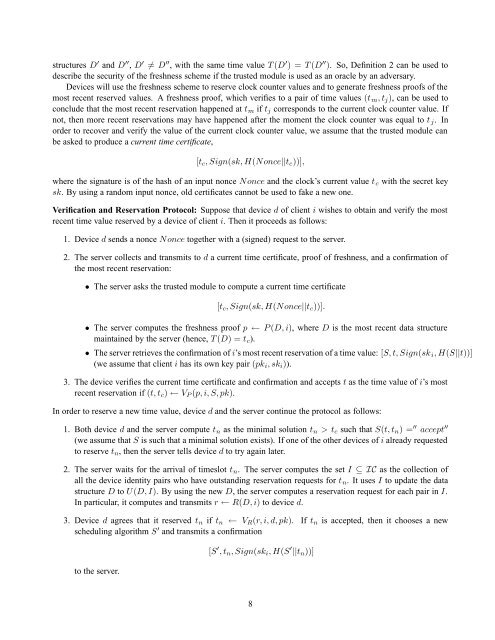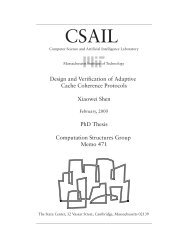Proof of Freshness - Computation Structures Group - MIT
Proof of Freshness - Computation Structures Group - MIT
Proof of Freshness - Computation Structures Group - MIT
You also want an ePaper? Increase the reach of your titles
YUMPU automatically turns print PDFs into web optimized ePapers that Google loves.
structures D ′ and D ′′ , D ′ = D ′′ , with the same time value T (D ′ ) = T (D ′′ ). So, Definition 2 can be used to<br />
describe the security <strong>of</strong> the freshness scheme if the trusted module is used as an oracle by an adversary.<br />
Devices will use the freshness scheme to reserve clock counter values and to generate freshness pro<strong>of</strong>s <strong>of</strong> the<br />
most recent reserved values. A freshness pro<strong>of</strong>, which verifies to a pair <strong>of</strong> time values (tm, tj), can be used to<br />
conclude that the most recent reservation happened at tm if tj corresponds to the current clock counter value. If<br />
not, then more recent reservations may have happened after the moment the clock counter was equal to tj. In<br />
order to recover and verify the value <strong>of</strong> the current clock counter value, we assume that the trusted module can<br />
be asked to produce a current time certificate,<br />
[tc, Sign(sk, H(Nonce||tc))],<br />
where the signature is <strong>of</strong> the hash <strong>of</strong> an input nonce Nonce and the clock’s current value tc with the secret key<br />
sk. By using a random input nonce, old certificates cannot be used to fake a new one.<br />
Verification and Reservation Protocol: Suppose that device d <strong>of</strong> client i wishes to obtain and verify the most<br />
recent time value reserved by a device <strong>of</strong> client i. Then it proceeds as follows:<br />
1. Device d sends a nonce Nonce together with a (signed) request to the server.<br />
2. The server collects and transmits to d a current time certificate, pro<strong>of</strong> <strong>of</strong> freshness, and a confirmation <strong>of</strong><br />
the most recent reservation:<br />
• The server asks the trusted module to compute a current time certificate<br />
[tc, Sign(sk, H(Nonce||tc))].<br />
• The server computes the freshness pro<strong>of</strong> p ← P (D, i), where D is the most recent data structure<br />
maintained by the server (hence, T (D) = tc).<br />
• The server retrieves the confirmation <strong>of</strong> i’s most recent reservation <strong>of</strong> a time value: [S, t, Sign(ski, H(S||t))]<br />
(we assume that client i has its own key pair (pki, ski)).<br />
3. The device verifies the current time certificate and confirmation and accepts t as the time value <strong>of</strong> i’s most<br />
recent reservation if (t, tc) ← VP (p, i, S, pk).<br />
In order to reserve a new time value, device d and the server continue the protocol as follows:<br />
1. Both device d and the server compute tn as the minimal solution tn > tc such that S(t, tn) = ′′ accept ′′<br />
(we assume that S is such that a minimal solution exists). If one <strong>of</strong> the other devices <strong>of</strong> i already requested<br />
to reserve tn, then the server tells device d to try again later.<br />
2. The server waits for the arrival <strong>of</strong> timeslot tn. The server computes the set I ⊆ IC as the collection <strong>of</strong><br />
all the device identity pairs who have outstanding reservation requests for tn. It uses I to update the data<br />
structure D to U(D, I). By using the new D, the server computes a reservation request for each pair in I.<br />
In particular, it computes and transmits r ← R(D, i) to device d.<br />
3. Device d agrees that it reserved tn if tn ← VR(r, i, d, pk). If tn is accepted, then it chooses a new<br />
scheduling algorithm S ′ and transmits a confirmation<br />
to the server.<br />
[S ′ , tn, Sign(ski, H(S ′ ||tn))]<br />
8
















